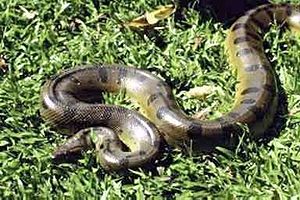Giant anaconda
Reports of giant anacondas date back as far as pre-Columbian times, playing a role in indigenous cultures of the Amazon Basin. European colonization of South America reported sightings of giant anacondas. The size of the largest anacondas has been the subject of debate ever since among cryptozoologists and zoologists.
Anacondas have been verified to grow to sizes of 5.21 metres (17.1 ft) and 97.5 kilograms (215 lb).[1] In particular, the green or common anaconda is the heaviest and largest among all extant snakes in terms of robustness, and it is also the second-longest.[2][3]
While the longest reputably-measured and confirmed anaconda was about 5.21 metres (17.1 ft) long,[1] extreme lengths far in excess of this have been reported for this species, without verification. Some claims describe anacondas ranging from 8 to 12 metres (26.2 to 39.4 ft), although these remain unverified.[4]
History[edit]

Giant anacondas play a role in the oral traditions of indigenous cultures as guardians of the river and its fauna, as well as bringers of storms and rain. They are said to form and guard Matupás, floating vegetation islands which have only recently in 2015 been discovered to be valuable components of the Amazon's ecosystems.[5]
Anacondas above 5 metres (16.4 ft) in length are rare. The Wildlife Conservation Society has, since the early 20th century, offered a large cash reward for live delivery of any snake of 30 feet (9.1 m) or more in length, but the prize has never been claimed, despite the numerous sightings of giant anacondas. In a survey of 780 wild anacondas in Venezuela, the largest captured was 17 feet (5.2 m) long.[6]
See also[edit]
References[edit]
- ↑ 1.0 1.1 Rivas, Jesús Antonio (2000). The life history of the green anaconda (Eunectes murinus), with emphasis on its reproductive Biology (PDF) (Ph.D. thesis). University of Tennessee. pp. 74–80, 111. Archived from the original (PDF) on 2016-03-03. Retrieved 2016-02-04. Unknown parameter
|url-status=ignored (help) - ↑ Soomro, A. 2001. "Eunectes murinus" (On-line), Animal Diversity Web. Accessed January 10, 2008 at http://animaldiversity.ummz.umich.edu/site/accounts/information/Eunectes_murinus.html
- ↑ Weldon, Kevin (1993). Encyclopedia of Animals: Mammals, Birds, Reptiles, Amphibians. Sydney, Australia: Reader's Digest Association Inc. p. 489. ISBN 1875137491. Search this book on

- ↑ Murphy, J. C.; Henderson, R. W. (1997), Tales of Giant Snakes: A Historical Natural History of Anacondas and Pythons, Krieger Pub. Cous., ISBN 0-89464-995-7.
- ↑ de Freitas CT, Shepard GH Jr, Piedade MTF (2015) The Floating Forest: Traditional Knowledge and Use of Matupá Vegetation Islands by Riverine Peoples of the Central Amazon. PLoS ONE 10(4): e0122542. https://doi.org/10.1371/journal.pone.0122542
- ↑ The Search for the $50,000 Snake. Archived 2009-10-31.
This article "Giant anaconda" is from Wikipedia. The list of its authors can be seen in its historical and/or the page Edithistory:Giant anaconda. Articles copied from Draft Namespace on Wikipedia could be seen on the Draft Namespace of Wikipedia and not main one.
